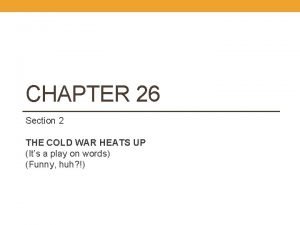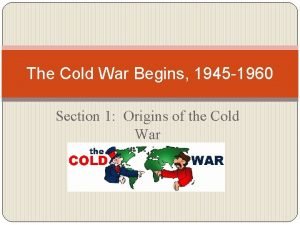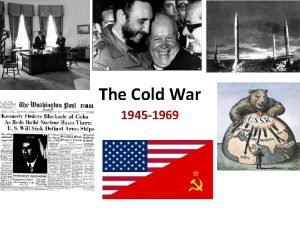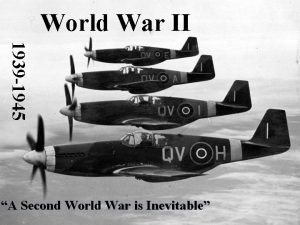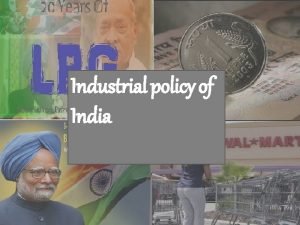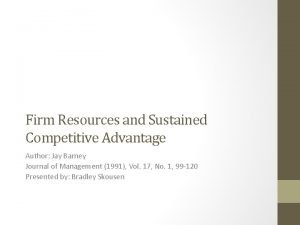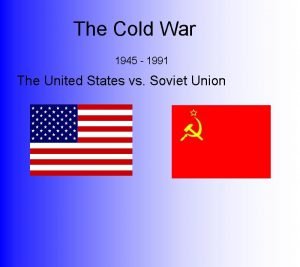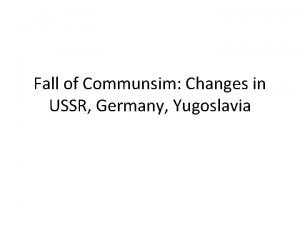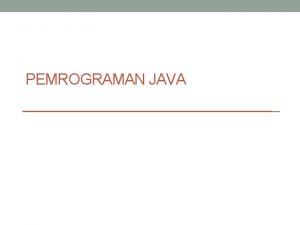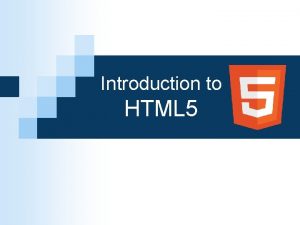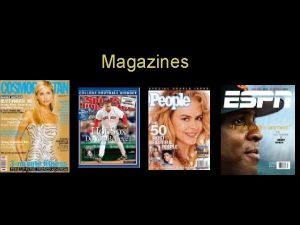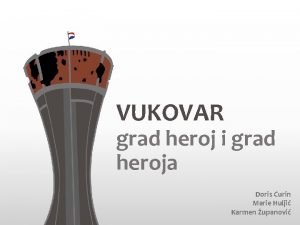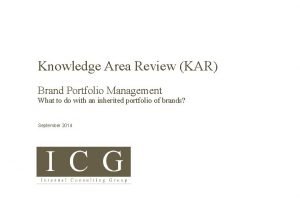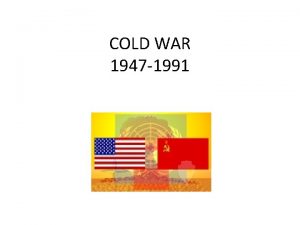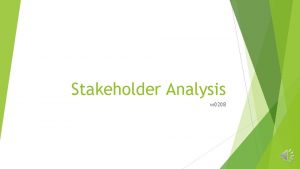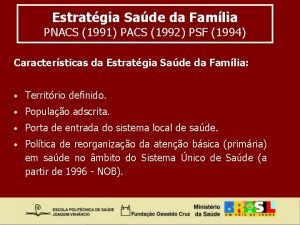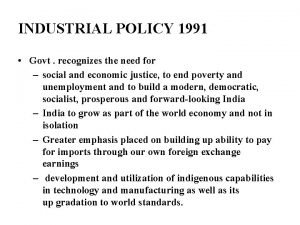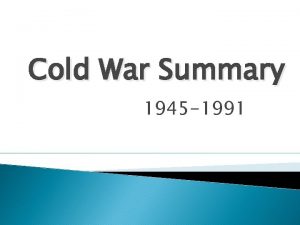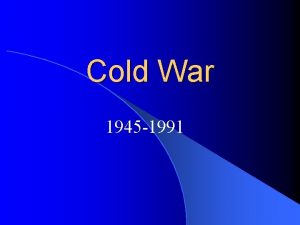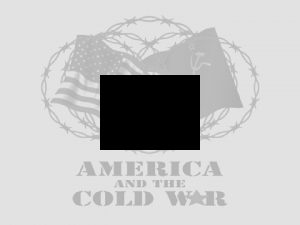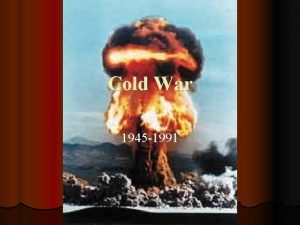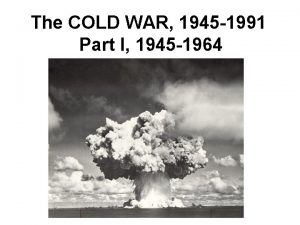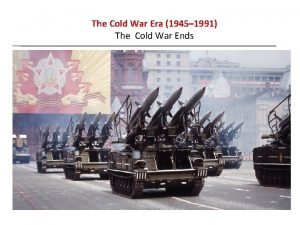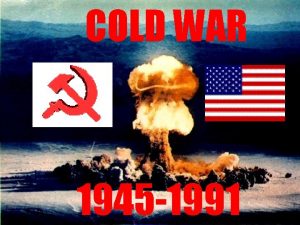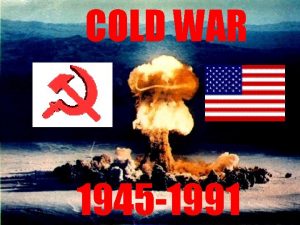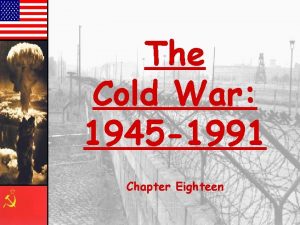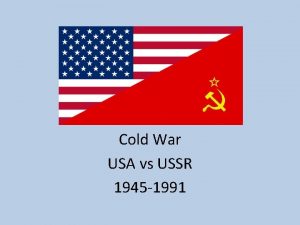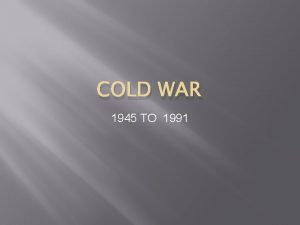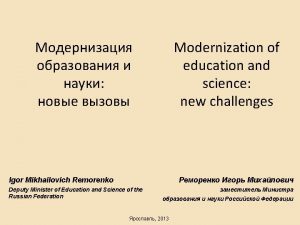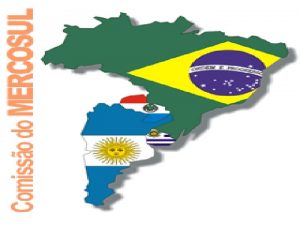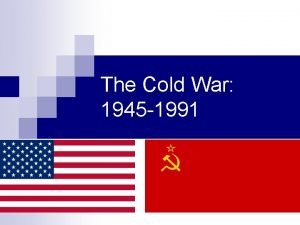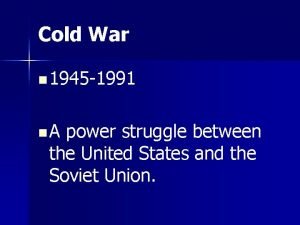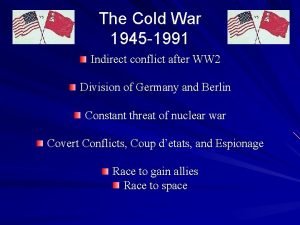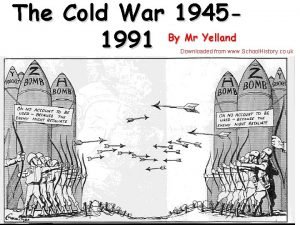The Cold War 1945 1991 Cold War w






















- Slides: 22

The Cold War 1945 -1991

Cold War? w Tension and rivalry between superpowers – U. S. (capitalist/democracy) vs. – USSR (communist dictatorship) w Not a fighting (hot) war – often very close to war (hotspots). • Berlin airlift • Cuban Missile Crisis – US/USSR avoid direct conflict to prevent nuclear war and mutually assured destruction (MAD) w Both used proxies (substitutes) in conflicts – either stop (US) or help (USSR) the spread of communism (U. S. ) • Fund arm rebels/opposition to governments aligned with other side. Examples: – USSR funds rebels in Angola, Congo, Sandinistas in Nicaragua, South America – US funds contras in Nicaragua, Jihadists in Afghanistan

Spread of Communism w Eastern Europe (late 1940 s) – Stalin reneges on promises to hold free elections w China (1949) – causes “red scare” – “Who lost China” w Cuba (1959) w SE Asia (1975)

Communism at greatest extent w Keep in mind the Sino-Soviet split divides the communist world by the early 1960 s – China says “peaceful coexistence” makes USSR weak

Key Terms w Containment – U. S. to prevent spread of Communism. • fears the “Domino Effect” – if one country falls to communism, then another, etc. – Vietnam → Cambodia → Laos w Mutually Assured Destruction – guaranteed destruction of BOTH superpowers in the event of a nuclear war. – “MAD”

The Arms Race Competition to have most powerful weapons. w w w 1945 U. S. bombs Japan 1949 Soviet A-Bomb 1952 U. S. H-Bomb 1953 Soviets H-Bomb Later race includes delivery systems – ICBMs (intercontinental ballistic missiles) – Submarine-based launch capability w Arms control agreements – Test ban treaties, SALT I & II (strategic arms limitation treaties), etc.

Hotspots w Korean War (1950 - 1953) – Communists from North invade S. Korea. • U. S. forces assist S. Korea • U. N. sends 15 -nation force (USSR in middle of boycott) w Cuba – Communist Fidel Castro takes power (1959) • US assists counterrevolutionary forces at Bay of Pigs (1961) • Cuban Missile Crisis (1962) w The U-2 Affair (1960) – American U-2 spy plane shot down over USSR. w Vietnam War (1955 - 1975) – French fight communists and leave; followed by U. S. – S. Vietnam, Laos & Cambodia => communist w Afghanistan (1979 - 1988) – Soviets invade Afghanistan to prop up communism • US supports jihadist opposition • Russia’s “Vietnam” w Various other “proxy” wars – Fueled by decolonization as superpowers jockey for influence over new states.

Khrushchev Era w Stalin dies (1953) w New leader Nikita Khrushchev denounces the policies of Stalin. – “destalinization” w Rejects idea of inevitable war with West – "peaceful coexistence” – but still bellicose • “We will bury you” – Kitchen debates w/Nixon w Sputnik – 1 st man made satellite – space race begins => NASA • Kennedy promises a man on the moon by end of 1960 s • US wins race (1969)

Sputnik II Laika

THE BERLIN WALL



1961 - Berlin Wall w Communists construct Berlin Wall to prevent East Germans from fleeing to West Berlin. – Many people attempted to escape to the West. – 86 people died trying to cross the Berlin Wall between 1961 and 1990. w Propaganda tool for West – “you need to build a wall to keep your people in”

Leonid Brezhnev Era (1964 – 1982) w General Secretary of the Communist Party – Khrushchev replaced shortly after Cuban Missile Crisis w hostile to internal reforms – tolerates corruption – leads to “Brezhnev stagnation” a period of socioeconomic decline w Supports policy of détente w/West – But engages in massive military buildup and interventionism • military budget is 12. 5% of GNP

Resistance to Communism in Eastern Europe w Hungary (1956) – Imre Nagy (leader) promises free elections, Soviets invade. w Czechoslovakia (1968) – Prague Spring reform crushed by Warsaw Pact forces. • “Brezhnev Doctrine” – USSR will use force to protect its interests in E. Europe w Poland (1980) – Labor union, Solidarity, led by Lech Walesa challenges communist govt. • Pope John Paul II (Polish cardinal, 1 st non-Italian pope in 450 years) – gave Poles courage to demand “peaceful change”

Détente • Period of reduced tensions between U. S. and USSR in 1960 s and 1970 s. • Arms Control Treaties • Helsinki Accords • triangulation • Nixon exploits Sino-Soviet split to strengthen America’s strategic position.

US – Soviet Cultural and Economic Differences w West = open, free democratic, dynamic – market-based economies (consumer makes all decisions, has the power) • abundant consumer goods – free exchange of ideas • free press, ability to protest, free movement w East = closed, restrictive, stagnant – command economies (government makes all decisions, consumer has no power) • focused on heavy industry • shortage of consumer goods – state-run press, religion repressed, no protest – Life under Communism

Milos Forman, director One Flew Over the Cuckoo’s Nest and Amadeus Defectors Martina Navratilova Mikhail Baryshnikov Stalin’s daughter, Svetlana

Ronald Reagan w U. S. President (1981 -1989). w Ramps up U. S. arms production. – “Star Wars” missile defense program w USSR is an “Evil Empire. ” w “Tear down this wall. ” Mikhail Gorbachev w Becomes leader of USSR (1985). – 1 st Gen’l Secretary not born under tsars w Ushered in an era of reform. – Perestroika • Economic reform- restructuring • Arms race bankrupted USSR – Glasnost • openness, allowed greater free expression and criticism

Ronald Reagan: “Tear Down This Wall” http: //vodpod. com/watch/526191 ronald-reagan-tear-down-this-wall Reagan Speech

1989 - Fall of Berlin Wall w Gorbachev renounces Brezhnev Doctrine w Refuses to intervene to crush pro-democracy movements in Eastern Europe w After massive public demonstrations in East Germany and Eastern Europe, the Berlin Wall fell. NBC News

1991 – USSR Collapses w Soviet Union officially dissolved. w Russian Federation (Russia) formed. – 15 constituent republics become independent states. w “New World Order” – U. S. only “superpower. ”
 Chapter 26 section 2 guided reading the cold war heats up
Chapter 26 section 2 guided reading the cold war heats up The cold war begins 1945-1960
The cold war begins 1945-1960 The cold war heats up: 1945 - 1969
The cold war heats up: 1945 - 1969 Welcome 1 unit 10 lesson 1
Welcome 1 unit 10 lesson 1 1945 world war
1945 world war 1945 world war ii
1945 world war ii Fought
Fought Industrial policy
Industrial policy Barney 1991 firm resources
Barney 1991 firm resources 1991
1991 December 25 1991
December 25 1991 Java diciptakan pada tahun
Java diciptakan pada tahun Alcock v chief constable of south yorkshire police
Alcock v chief constable of south yorkshire police River severn facts
River severn facts Html 1991
Html 1991 Martha stewart living masthead
Martha stewart living masthead Linux 1991
Linux 1991 Vukovar 1991
Vukovar 1991 Brand architecture
Brand architecture 1947 1991
1947 1991 Onion model stakeholder analysis
Onion model stakeholder analysis Pnacs
Pnacs Industrial licensing policy 1991
Industrial licensing policy 1991
